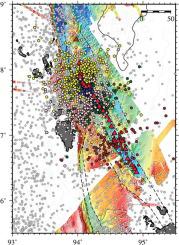Journal of Asian Earth Sciences ( IF 3 ) Pub Date : 2021-09-08 , DOI: 10.1016/j.jseaes.2021.104948 Karanam Kattil Aswini 1, 2 , Kattoju Atchuta Kamesh Raju 1, 3 , Pawan Dewangan 1 , Vadakkeyakath Yatheesh 1 , Pabitra Singha 1 , Telluri Ramakrushana Reddy 1

|
The Andaman Sea has experienced a number of earthquake swarms as a result of complex tectonics arising from oblique subduction, active volcanic arc, the backarc spreading center, and sliver fault systems. One of the most energetic offshore earthquake swarms occurred in the off Nicobar region of the Andaman Sea in January 2005, following the 26th December 2004 (9.1 Mw) Sumatra megathrust event. After a brief quiescence, this region got reactivated again after the 21st March 2014 (6.5 Mw) event, followed by the occurrence of earthquake swarms in March 2014, October 2014, November 2015, and April 2019. In the present study, we analysed the temporal variation of the b-value of these swarms using the global network data and the Ocean Bottom Seismometer data to understand their genesis. Temporal variation of b-value suggests that b-values are larger than unity for earthquake swarms, indicating volcanic origin. Bimodal distribution of frequency magnitude relation suggests that the earthquake swarms have occurred due to complex seismic processes controlled by both tectonic and volcanic activities. We propose that a combination of magmatic pulsation in the arc volcanism in response to 2004 and 2005 megathrust events and the 6.5 Mw magnitude 21st March 2014 event in off Nicobar region, and reactivation of sliver fault systems, are the dominant mechanisms for the observed frequent earthquake swarms.
中文翻译:

安达曼海尼科巴附近地震群的地震构造评价
由于倾斜俯冲、活动火山弧、弧后扩张中心和狭长断层系统产生的复杂构造,安达曼海经历了多次地震群。其中最有活力的海上震群发生在安达曼海关闭尼科巴地区在2005年1月,在2004年12月26日(9.1米以下w ^)苏门答腊大型逆冲断层事件。在短暂的静止之后,该区域在 2014 年 3 月 21 日(6.5 M w) 事件,随后在 2014 年 3 月、2014 年 10 月、2015 年 11 月和 2019 年 4 月发生了地震群。在本研究中,我们使用全球网络数据和海洋分析了这些群 b 值的时间变化底部地震仪数据以了解其成因。b 值的时间变化表明 b 值大于地震群的统一值,表明火山起源。频率幅度关系的双峰分布表明地震群的发生是由于构造和火山活动控制的复杂地震过程。我们提出,响应 2004 年和 2005 年巨型逆冲事件和 6.5 M w的弧火山活动中的岩浆脉动的组合 2014 年 3 月 21 日在尼科巴地区发生的震级事件和狭长断层系统的重新激活是观察到的频繁地震群的主要机制。



























 京公网安备 11010802027423号
京公网安备 11010802027423号